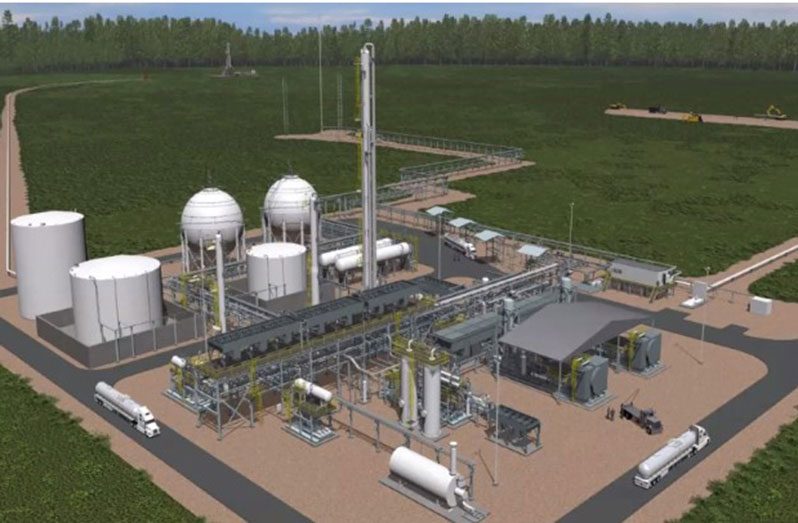–Dr. Jagdeo says, dispels rumours that project will be delayed
GENERAL Secretary of the People’s Progressive Party (PPP) Dr. Bharrat Jagdeo has set the record straight and maintained that the gas-to-energy project is on schedule.
This comes as a direct response to a Reuters’ article, headlined: “Guyana gas-to-power project to shave weeks off oil output, hit revenue”, and the Opposition’s sudden hysteria over this piece.
During a press conference at the party’s headquarters on Thursday, the PPP General Secretary extensively emphasised how the project will better the lives of all Guyanese.
He said that the project has several components, the first being the pipeline; the second building of the Power Plant and the Natural Gas Liquids (NGL) facility; thirdly, the transmission main to move the power to the control centre; fourthly, the control centre, and fifthly the upgrade of the transmission and distribution system.
“So, five separate components that will make this a major project that will solve our electricity needs for long into the future; prepare us for an industrial era and a modern era for supply of power,” Dr. Jagdeo said.
He further related that the gas-to-energy project was started “from scratch”, as the government was examining ways in which they could give the country a cheaper form of fuel.
As to why Wales, West Bank Demerara (WBD) is the most feasible location as opposed to Palmyra, East Berbice-Corentyne, Dr. Jagdeo explained that the latter has more “swampy conditions” and would have caused problems.
Additionally, the generation of power was tabled as another element in the creation of the gas-to-energy project.
According to Dr Jagdeo: “If you include the price of gas, it will probably be about six or seven cents, but gas is free. So, what will it take for us to pay back for this whole project? It came up to about four US cents per kilowatt hour, considering now we are generating at over 20 cents per kilowatt hour.”
He stated that the project will save the country a minimum of US$100 million per year.
The first element of the project was setting aside funds for the pipeline, and according to him, a billion dollars was set aside for the pipeline, and that included the upgrading of the roads to get to the site, the material offloading facility, a site preparation for 100 acres and included a laydown yard.
“So, the completed project, as per contract,” he said, “is end 2025. That is the completed project; the end of the project has not shifted.” But, according to him, the delay is as a result of a late handover by Exxon’s contractors that were responsible for the pipeline laying aspect.
Furthermore, he raised the subject of liquidated damages if the project is not completed on time.
“If they don’t complete the project on time, it is over US$11 million per month they have to pay in liquidated damages for delay on the project,” Dr. Jagdeo said.
He further deflated the argument that ExxonMobil’s Floating Production Storage and Offloading (FPSO) vessel connection will result in a loss of four weeks of production, and said that this was already taken into account and that it should only take two weeks.
The PPP General Secretary said: “Our estimate with Exxon given to us is two weeks. So, each of these FPSOs would have to be shut down for two weeks to connect the pipeline…this was taken into account in our forecast for the revenue for this year…this was considered right from the beginning.
“They are hoping to bring forward maintenance for that period on the FPSOs for the period when they have to shut them down to make the connection.”
He added that ExxonMobil is looking to alter its maintenance plan to run simultaneously with this timing.
The project, which involves laying a 200km, 12-inch diameter pipeline, will channel natural gas from the Liza Phase One and Phase Two FPSO vessels to a state-of-the-art power plant and Natural Gas Liquids (NGL) facility in Wales.
Esso Exploration and Production Guyana Limited (EEPGL), along with its co-venturers in the Stabroek Block, are behind the pipeline’s construction, which has an estimated cost of US$1 billion and is cost recoverable.
The Government of Guyana has earmarked $80 billion in the 2024 budget for the project, highlighting its significance to national development.
The conversion of natural gas from ExxonMobil’s offshore operations to electricity is a key component of the People’s Progressive Party/Civic (PPP/C) government’s objective to lower energy costs by at least 50 per cent through an energy mix which incorporates gas, solar, wind, and “hydro” power.



.jpg)










